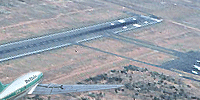 |
 |
|
||||
|
By
Wikipedia, Aeroacoustics is a branch of acoustics that studies noise generation via either turbulent fluid motion or aerodynamic forces interacting with surfaces. Noise generation can also be associated with periodically varying flows. Although no complete scientific theory of the generation of noise by aerodynamic flows has been established, most practical aeroacoustic analysis relies upon the so-called Acoustic Analogy, whereby the governing equations of motion of the fluid are coerced into a form reminiscent of the wave equation of "classical" (i.e. linear) acoustics. Aeroacoustics is that branch of one,which deals with the study of noise generation through,either turbulent fluid motion or aerodynamic forces interacting with surfcaces. The most common and a widely-used of the latter is Lighthill's aeroacoustic analogy. It was proposed by James Lighthill in the 1950swhen noise generation associated with the jet engine was beginning to be placed under scientific scrutiny. Computational Aeroacoustics (CAA) is the application of numerical methods and computers to find approximate solutions of the governing equations for specific (and likely complicated) aeroacoustic problems. Lighthill's equationLighthill rearranged the Navier–Stokes equations, which govern the flow of a compressible viscous fluid, into an inhomogeneous wave equation, thereby making a connection between fluid mechanics and acoustics. This is often called "Lighthill's analogy" because it presents a model for the acoustic field that is not, strictly speaking, based on the physics of flow-induced/generated noise, but rather on the analogy of how they might be represented through the governing equations of a compressible fluid. The first equation of interest is the conservation of mass equation, which reads where ρ and Next is the conservation of momentum equation, which is given by where p is the thermodynamic pressure, and σ is the viscous (or traceless) part of the stress tensor. Now, multiplying the conservation of mass equation by Note that Subtracting which is equivalent to where The above equation is the celebrated Lighthill equation of aeroacoustics. It is a wave equation with a source term on the right-hand side, i.e. an inhomogeneous wave equation. The argument of the "double-divergence operator" on the right-hand side of last equation, i.e. Using Einstein notation, Lighthill’s equation can be written as where and δij is the Kronecker delta. Each of the acoustic source terms, i.e. terms in Tij, may play a significant role in the generation of noise depending upon flow conditions considered. ρvivj describes unsteady convection of flow (or Reynold's Stress), σij describes sound generated by shear, and In practice, it is customary to neglect the effects viscosity of the fluid, i.e. one takes σ = 0, because it is generally accepted that the effects of the latter on noise generation, in most situations, are orders of magnitude smaller than those due to the other terms. Lighthill provides an in-depth discussion of this matter. In aeroacoustic studies, both theoretical and computational efforts are made to solve for the acoustic source terms in Lighthill's equation in order to make statements regarding the relevant aerodynamic noise generation mechanisms present. Finally, it is important to realize that Lighthill's equation is exact in the sense that no approximations of any kind have been made in its derivation. Related model equationsIn their classical text on fluid mechanics, Landau and Lifshitz derive an aeroacoustic equation analogous to Lighthill's (i.e., an equation for sound generated by "turbulent" fluid motion) but for the incompressible flow of an inviscid fluid. The inhomogeneous wave equation that they obtain is for the pressure p rather than for the density ρ of the fluid. Furthermore, unlike Lighthill's equation, Landau and Lifshitz's equation is not exact; it is an approximation. If one is to allow for approximations to be made, a simpler way (without necessarily assuming the fluid is incompressible) to obtain an approximation to Lighthill's equation is to assume that And for the case when the fluid is indeed incompressible, i.e. ρ = ρ0 (for some positive constant ρ0) everywhere, then we obtain exactly the equation given in Landau and Lifshitz , namely A similar approximation [in the context of equation Of course, one might wonder whether we are justified in assuming that However, even after the above deliberations, it is still not clear whether one is justified in using an inherently linear relation to simplify a nonlinear wave equation. Nevertheless, it is a very common practice in nonlinear acoustics as the textbooks on the subject show: e.g., Naugolnykh and Ostrovsky and Hamilton and Morfey. See also
External links
Text from Wikipedia is available under the Creative Commons Attribution/Share-Alike License; additional terms may apply.
Published in July 2009. Click here to read more articles related to aviation and space!
|

 |
|
Copyright 2004-2025 © by Airports-Worldwide.com, Vyshenskoho st. 36, Lviv 79010, Ukraine Legal Disclaimer |